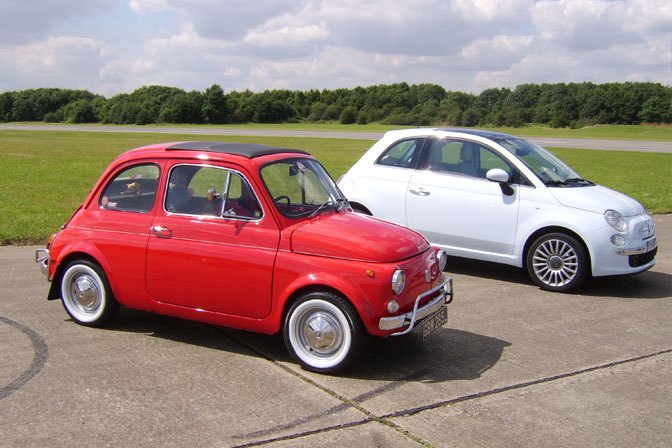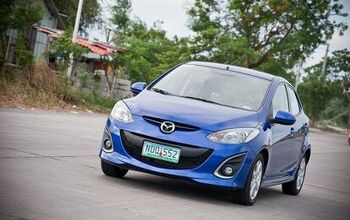Review: 2011 Fiat 500 1.2 (European-Spec)
Retro cars sell on looks. Take the Chrysler PT Cruiser as an example – automotive perfection it wasn’t, and yet it sold like iPods on a Black Friday. Others, like the Mini Cooper, proved that retro cars can look like the past and drive like the present. But worth driving or not, almost every retro car introduced over the last few years has been a marketing sensation, bringing easy revenue and much-needed customers into an otherwise dull product line, and reviving deserted showrooms. No surprise, then, that upon reviewing the stellar sales of the Ford Mustang, Mini Cooper and the Volkswagen New Beetle, Fiat’s chiefs in Torino decided that it was time to launch a true Italian vendetta. It didn’t take long to find inspiration: the instant choice was the Fiat 500.
The Fiat 500 is to Italy what the iconic Beetle is to Germany. A small, bread-and-butter car that put a shiny new automobile in every driveway in a country plagued by post-war trauma. Introduced in 1957 and produced through 1975, nearly 3.9 million 500s were made over the years – and some 400,000 of them still travel on the roads of Europe today.
So, Fiat’s designers put their retro hats on, and in 2007, the new Fiat 500 – or cinquecento, as the Italians call it – was born. The new 500 is remarkably similar to its predecessor with a flowing and harmonic design which softly mutters – rather than screams – retro. In flowing Italian.
The end result of Fiat’s effort is a car that people smile at – on the streets, in parking lots and in traffic jams. Not many cars can be called ‘sweet’, but the Fiat 500 can definitely satisfy any automotive sweet tooth.
Unlike BMW with the MINI, Fiat has decided to indulge in some clever platform sharing. Underneath the shiny bodywork of the 500 lies a much less shiny car – the Fiat Panda, also the cheapest car the Italian company currently offers. And they have a very good reason for this, as the 500 significantly undercuts the Cooper in its pricing.
Does it show? In a word, yes. The interior continues the retro trend with shiny plastic that is color-coded with the exterior – it does look like an original effort, but a quick touch reveals the sound of hollow, low-grade plastic that’s not at all satisfying to touch. The interior is, however, well put together and otherwise very pleasant to look at, with nice touches and attention to detail – like the chrome surroundings around the buttons.
There are also some obligatory Italian-engineering quirks included with the 500. Take, for example, the seat reclining lever which is awkwardly hard to reach or the unnecessarily-complex gearlever on our automatic tester.
Space up front is not bad and the funky looking seats are good, but
getting comfortable in the rear is a challenging experience. Although, surprisingly, rear legroom and space is ample, our tester’s rear seats were more of a bench, providing an awkward sitting position that inspired backaches after mere minutes of commuting. You do pay – handsomely – for this relative comfort, with the trunk measuring a miserly 185 liters (6.5 cubic feet), so don’t go planning any road trips.
Under the hood of our Euro-spec tester was a 1.2 four-banger unit putting out 70 horsepower. Combined with a curb weight of 1900 pounds, you may have already guessed this 500 won’t win any drag races, completing the sprint to 60 in just under 13 seconds. There is also a more powerful 1.4 unit with 100 horsepower, and of course – the Abarth with its 1.4 TurboJet engine pumping out 133 horeses (and a more impressive 7.9 second sprint to 60).
Our tester was also equipped with an optional Dualogic automatic transmission. This is no regular automatic though – it’s a single-clutched, manual based, computer controlled unit. Although it’s not a bad effort for this kind of a gearbox, after Volkswagen has shown us how to execute the semi-autobox it with its DSG dual clutch gearbox, it’s hard to go back. This transmission offers slightly jerky performance in heavy traffic and doesn’t shift as smoothly as a conventional automatic or VW’s said gearbox. There is a clever Hill Hold feature, which will hold the brake pedal for you for 3 seconds to prevent rolling down hills, but we’d rather pick the stick or a conventional automatic which may or may not be added for the American market.
But perhaps the most disappointing part about the 500 is its ride. In its seemingly natural habitat – urban areas – this Fiat provided a jerky and uncomfortable ride, crashing over bumps and minor road imperfections with what appears to be very short suspension travel. This condition improved when taken to the freeway, but we’d gladly trade some cruising comfort to spare our backs in town, not to mention that the 500 doesn’t feel very much at home cruising on the highway.
The upside to the harsh ride is the handling, which is good. It’s not as composed as say, well, the Mini Cooper, but the 500 is still a fun car in the corners, although we were limited in this judgment by the engine’s lack of grunt. The electrically assisted steering is a little too light and lacks a certain amount of feel, but all-in-all the result is fair enough. For tight parking spots and difficult urban maneuvers, Fiat has provided a magic button which makes the steering even lighter – frighteningly so.
So, what about the United States? Well, there are several question marks left, but the 500 is well on its way stateside as part of Fiat’s attempt to re-enter the American market after leaving with its tail between its legs back in the 80s. It will be produced in one of Chrysler’s North American factories, and the convertible version of the Italian mini car, called 500C, will also make it across the pond. There are also plans for a wagon-esque spinoff (read: Mini Cooper Clubman).
At least for the time being, however, Chrysler-Fiat have no intention of opening a separate Fiat dealer-network, so that the 500 will be sold in Chrysler showrooms, and well, we can see some problems with the idea, separate showroom floor notwithstanding.
But back to the car. The 500 proves that Fiat can do retro too. And
although the obvious comparison to the Mini Cooper (fun fact: both cars were designed by the same man), the Fiat 500 is smaller and cheaper – and it doesn’t manage to hide it.
Financially, the 500 makes very little sense. It isn’t very comfortable, quality could use a brush up and it’s not the most rewarding car in the world to drive (the Abarth should fix that impression, though). Yes, it is cheaper than the Mini, but it’s by no means cheap. You could probably buy a modern, well-equipped sub-compact for the 500’s non-retro price, but that would be using common sense, and common sense just doesn’t apply here.
You see, the 500 has this sense of occasion to it. It’s a (relatively) cheap-and-(very) cheerful car, if you like – and it’s been a while since we could genuinely say this about any new car. It functions better as a fashion accessory than a practical solution, and if that’s your cup of tea, you might as well take a long sip. Did we mention that retro cars tend to sell on their looks?
This test drive made possible by iCar.co.il
More by Tal Bronfer
Latest Car Reviews
Read moreLatest Product Reviews
Read moreRecent Comments
- Lou_BC A pickup for most people would be a safe used car bet. Hard use/ abuse is relatively easy to spot and most people do not come close to using their full capabilities.
- Lorenzo People don't want EVs, they want inexpensive vehicles. EVs are not that. To paraphrase the philosopher Yogi Berra: If people don't wanna buy 'em, how you gonna stop 'em?
- Ras815 Ok, you weren't kidding. That rear pillar window trick is freakin' awesome. Even in 2024.
- Probert Captions, pleeeeeeze.
- ToolGuy Companies that don't have plans in place for significant EV capacity by this timeframe (2028) are going to be left behind.






































Comments
Join the conversation
It´s true that some people needs big cars, but here(Sweden) we have a large number of single commuters that don´t need a land yacht or a monster suv. And who said that you only can have one car for all your possible needs? Moparman426w: Here in Sweden we also have wide open spaces, and some of us happen to own homes. I assume that you own a big car?
"Retro cars sell on looks. Take the Chrysler PT Cruiser as an example – automotive perfection it wasn’t, and yet it sold like iPods on a Black Friday." That is a nice turn of phrase there.